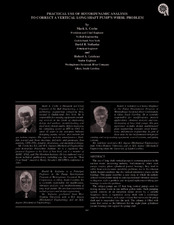| dc.description.abstract | The use of long shaft vertical pumps is common practice in the nuclear waste processing industry. Unfortunately, when such pumps employ plain cylindrical journal bearings, they tend to suffer from rotordynamic instability problems due to the inherent lightly-loaded condition that the vertical orientation places on the bearings. This paper describes a case study in which the authors utilized rotordynamic analysis and experimental vibration analysis to diagnose such a problem and designed replacement tilting-pad bearings to solve the problem. The subject pumps are 45 foot long vertical pumps used for mixing nuclear waste in one million gallon tanks. Each pumping system consists of an induction motor driven by a variable frequency drive, a segmented pump shaft with a centrifugal impeller at the bottom, and a pipe column that surrounds the pump shaft and is suspended into the tank. The column is filled with water that serves as the lubricant for the eight plain cylindrical journal bearings that support the pump shaft. Unfortunately, these pumps have been plagued with vibration related problems, such as bearing and seal failures, ever since they were commissioned. In order to evaluate the problem, the pump shaft and column were instrumented with vibration transducers, and vibration testing was performed. This testing revealed that subsynchronous whirling, at approximately one-half the running speed, was the primary culprit responsible for the failures. In an effort to understand the cause of the observed vibrations, a two-level rotordynamic model of the pump shafting and column was constructed. This rotordynamic model, like those for many vertical pumps, was far from routine. The rotordynamic analysis, which is described in detail, then successfully confirmed that the problem was subsynchronous whirling due to rotordynamic instability. This analysis was then used to guide the design of tilting-pad bearings employing offset pivots and geometric preload to replace the original plain cylindrical bearings and, thereby, resolve the instability problem. The plain cylindrical bearings were removed from a pump, tilting-pad bearings were installed, and subsequent testing verified the predicted vibration reduction. Accordingly, the application of tilting-pad bearings, whose design is described in detail, was conclusively shown to be an effective solution for this specific problem. | en |


